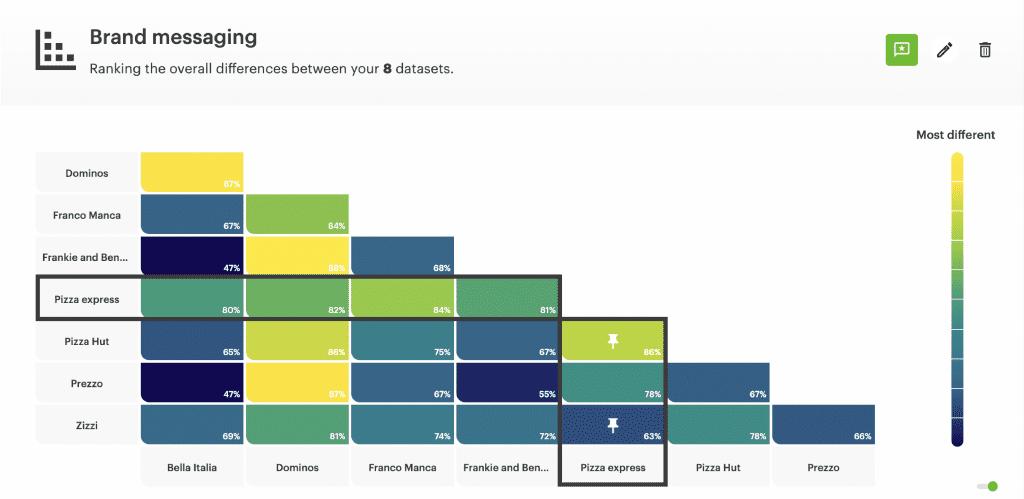Why is it important to know your competition in business?

Knowing your competition in business is critical to success. After all, how can you expect to survive in an industry if you don’t understand who the major players actually are?
In a landscape where every brand is fighting for its slice of a limited market, competitor analysis can help businesses cut through the noise, establish a unique selling point and formulate an effective business strategy.
Why is it important to know your competition in business?
Find your competitive advantage and drive brand strategy
Identifying what differentiates your brand, product or service from other players in the industry is one of the main benefits of competitor analysis, and is crucial to increasing sales and building customer loyalty. By understanding the strengths of your brand, recognizing your weaknesses and finding your unique value proposition, you’ll know exactly what it is that you bring to the table.
Armed with this knowledge, you can communicate your true value to consumers, adapt your brand and communications strategy accordingly and win back market share.
Understand your competitor’s current business strategy
Sun Tzu“If you know thy enemy and know thyself, you need not fear the result of a thousand battles”.
Just as it is important to find your competitive advantage, if you know your competition’s movements, weak spots, strengths and marketing strategies, you can ultimately stay ahead of the game.
Businesses need to know who their competition is, what they are doing or have already tried to do, in order to discover traits and tactics that they can use to their advantage. Often, a real benefit of competitor analysis is learning what your competitors are doing before trying out something new yourself.
Learn more by watching our webinar on the benefits of competitor analysis.
Discover opportunities and gaps in the market
Competitor analysis can help you understand the current frustrations of customers and ultimately uncover new opportunities for your business. By understanding where your competitors are missing the mark, you have a chance to exploit these gaps in the market and provide consumers with an effective solution.
For new companies and those looking to expand, by identifying white space or finding a niche you can be assured that you’re not entering an overcrowded market.
Using Relative Insight to better know your competition
Relative Insight is a text analytics platform that uses comparison to showcase the differences, frequencies and similarities in how competitors and audiences speak.
Our unique technology compares two or more qualitative data sets, pinpointing the linguistic features that are more prevalent in one text over another – the words, phrases, topics, grammar and emotions that competitors and consumers are more likely to use.
The Relative Insight software can analyze any form of text data, making it easier to compare competitor data side by side. Common data sources used for competitor benchmarking projects include: voice of the customer data (reviews), marketing collateral (website copy, emails, advertising material, branded communications) and social listening data.
A new way of thinking
Relative Insight helps businesses reap the benefits of competitor analysis, simplifying like-for-like comparisons and helping them to inject a new way of thinking into their competitor research in three key ways:
1. Discover which competitors are most and least different
Relative Insight’s Heatmaps functionality is a visual output that can quickly and easily identify which competitors you are most and least different to.

2. Giving context to quantitative metrics
Social media listening tools make it easy for brands to measure which competitor has the largest share of voice. However, text analysis helps you pin down why. Analyzing qualitative data gives context to quantitative metrics and provides actionable insights that can influence your position in the market.
3. Scalable and efficient competitor analysis
Relative Insight analyzes vast amounts of text data quickly and accurately. It provides you with an objective solution to examining millions of words without having to read them, making competitor analysis an efficient and scalable process.
Competitor benchmarking with Relative Insight
Building comparisons through Relative Insight reveals how your brand fits into the market, what the strengths and weaknesses of your competitors are and how you measure up in the eyes of your consumers. Four common types of competitor comparisons include:
Brand messaging
Compare the marketing collateral, brand messaging and website copy of competing brands to understand what language and tone of voice competitors are adopting to promote their own products and services. Understand the marketing strategy of your competitors and how you can differentiate your brand from the competition – only then will you truly know your competition.
Brand perception
Track brand mentions to discover the differences in what consumers and media outlets are saying about you and your competition. Uncover how people are talking about your organization, products or services in relation to competitors, helping you to understand the overall perception of your brand.
Voice of customer feedback
Conduct customer feedback analysis to reveal the strengths and weaknesses of your competitors. Discover your own unique selling points and limitations in the eyes of your consumers and understand what underpins consumer preferences. Utilize insights to inform product development and improve customer experience.
Talent & employer brand
Get to better know your competition by comparing job descriptions to understand how your competitors are attracting talent and ensure you’re remaining competitive as an employer. Analyze employee review data to gain a better understanding of the competitive landscape from an employee’s point of view and discover how you are perceived as an employer.
